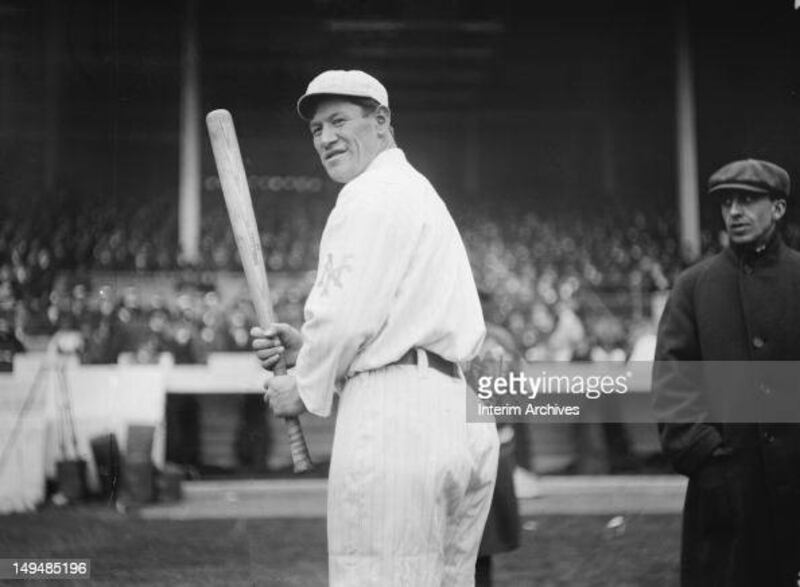At the junction of Joe Boyle Circle and Route 903, three flags stand silent sentry over the tomb of Jim Thorpe. On each side of a rectangular mausoleum hewn from 20 tonnes of granite, images echoing the cadences of his life are carved into relief. Amid the poses of an athlete running, hurdling, jumping, and throwing, there is a baseball player at bat, a running back fending off a tackle, and a Native American in feathered headdress astride a horse. Beneath them all runs the legend: “Sir, you are the greatest athlete in the world - King Gustav V, Stockholm, Sweden, 1912 Olympics.”
This rustic corner of north-eastern Pennsylvania is the final resting place of the gold medal winner in the decathlon and pentathlon at those games, outfielder on the New York Giants team that lost the 1917 baseball World Series, storied contributor to what is now the National Football League, and Sac and Fox Indian. When the Associated Press held a vote in 1950 to establish the greatest athlete of the half-century, Thorpe polled nearly twice as heavily as his nearest challengers, Babe Ruth and Jack Dempsey. In the pantheon, this is the kind of company he keeps, but his legend retains a lustre all its own.
The monument that hints at the extraordinary range of his prowess scarcely captures the tumult of his existence. His response to the Swedish monarch’s sweeping encomium had been a simple, charming: “Thanks, King”, but, six months later it emerged that Thorpe, like so many of his peers, had flouted the Olympic amateur ideal by playing semi-pro baseball for $2 a game while in college. His mistake was playing under his own name and he was stripped of his medals. It took his children campaigning until 1982 to get the International Olympic Committee (IOC) to award the family duplicate golds and, kind of ridiculously, to name him co-champion of the events he won outright.
Last Friday, another forty years down the line, the IOC gave him back his reputation in full. Finally. Belatedly.
World Cup 2026 European qualifiers draw: All you need to know about Ireland’s potential group
Irish rugby is a good place to be, thanks to people such as Dave Fagan
No game illustrated the widening gulf between Europe’s elite and the rest than Toulouse’s mauling of Ulster
Provinces gear up for more European action as rugby pays tribute to Dave Fagan
On the 110th anniversary of his decathlon triumph (he beat the nearest challenger, Sweden’s Hugo Weislander, by a mere 688 points), it was announced the record books will be rewritten to recognise Thorpe as sole winner of both events. Of course, righting the grievous wrong came much too late for the man himself who carried the stigma of scandal for the rest of his life, even while lighting up baseball and gridiron with his array of skills.
His influence as a player in the latter code’s fledgling decades, still suiting up at 42, was such that a statue of Thorpe is the first thing a visitor encounters at the American Football Hall of Fame in Canton, Ohio. Once that career ended, however, he led a somewhat undulating existence. He went through three marriages and a succession of jobs, from being in charge of casting Native American characters in Western films to digging ditches. He battled booze, did a stint as a merchant marine, and sold the film rights to his biography to Hollywood for a paltry $1500. Pittance for an epic.
His father Hiram, the grandson of an Irish immigrant, peddled whiskey, traded horses and turned his hand to whatever else he could to keep his family alive in the Oklahoma Territory in the late 19th century. From an early age, the precocious Jim mastered the lasso and, by 15, it was said there was no wild horse on the prairie he could not catch, saddle and ride. Reared on trapping and hunting, he developed the ability to mimic the movement of any prey. Legend had it he threw a javelin to Olympic standard after spending just a couple of hours studying others doing it.

His preference for the outdoors over the classroom brought him into constant conflict with his father who eventually enrolled him at Carlisle Indian College in faraway Pennsylvania. Under the brutal stewardship of Lieutenant Richard Henry Pratt, the expressed purpose of the institution was to eradicate students’ native heritage, the motto being, “Kill the Indian, Save the Man!” If the true extent of the suffering endured by children there is only recently coming to light (at least 200 pupils died from physical abuse), it was where Thorpe gained formal athletic training and first launched himself onto the American sports landscape as a football prodigy.
He died from a heart attack, broke and alcoholic, living in a California trailer park, in 1953, and then suffered yet more ignominy. After a couple of failed negotiations, Thorpe’s third wife, Patricia Askew, eventually sold his remains to the twin communities of Mauch Chunk and East Mauch Chunk for cash, and an assurance that they would commemorate him suitably. A pair of towns in Pennsylvania that he’d never visited rechristened their new conurbation Jim Thorpe, and hoped their investment in a famous corpse and a resonant name would make his tomb a morbid tourist attraction.
It didn’t. And now that the Olympic calumny has been rectified, there remains the ongoing and equally important campaign to repatriate him. According to Sac and Fox tradition, Thorpe will never be at peace until his bones are laid to rest, attended by appropriate tribal customs and ceremony, back in his native Oklahoma. Until then, his soul is doomed to wander, his enduring spiritual dislocation the story of his life and death.






